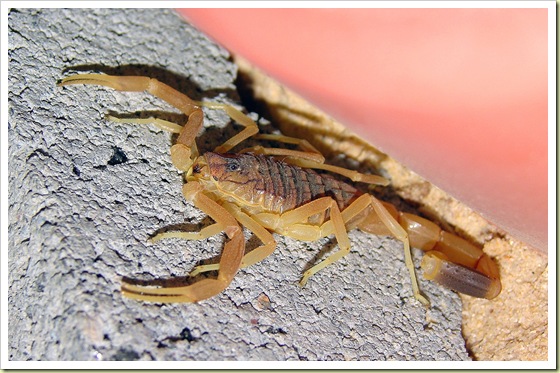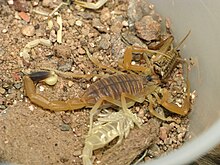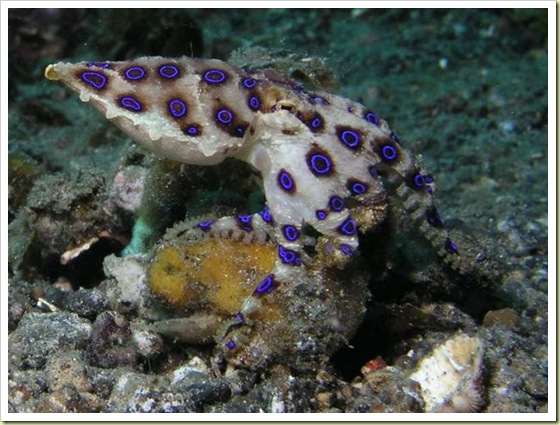
Contrarily to the popular belief most of the scorpions are relatively harmless to humans as stings produce only local effects (pain, numbness or swelling). However, the Death Starker Scorpion is highly dangerous species because its venom is a powerful cocktail of neurotoxins which causes an intense and unbearable pain, then fever, followed by coma, convulsions, paralysis and death. Fortunately, while a sting from this scorpion is extremely painful, it would be unlikely to kill a healthy, adult human. Young children, the old, or infirm (with a heart condition) are at the biggest risk.
Death stalker scorpions are spread in North Africa and Middle East.
The deathstalker (Leiurus quinquestriatus), is a species of scorpion, a member of the Buthidae family. It is also known as the Israeli yellow scorpion, Palestine yellow scorpion[1][2][3][4] Omdurman scorpion, Naqab desert scorpion and many other colloquial names, which generally originate from the commercial captive trade of the animal. To eliminate confusion, especially important with potentially dangerous species, the scientific name is normally used to refer to them. The nameLeiurus quinquestriatus roughly translates into English as "five-striped smooth-tail". Other species of the genus Leiurus are also often referred to as "deathstalkers".
Contents
[hide]Description[edit]
L. quinquestriatus is yellow, and 30–77 millimetres (1.2–3.0 in) long, with an average of 58 mm (2.3 in).[5]
Geographic range[edit]
L. quinquestriatus can be found in desert and scrubland habitats ranging from North Africa through to the Middle East. Countries where it lives include Algeria, Bahrain, Chad, Egypt, Ethiopia, Libya, Mali, Niger, Somalia, Sudan, Tunisia, Iraq, Jordan, Kuwait, Lebanon, Oman, Iran, Afghanistan, Israel, Pakistan, India, Qatar, Saudi Arabia, Syria, Turkey, Kazakhstan, Uzbekistan, United Arab Emirates, and Yemen.
Venom[edit]
Neurotoxins in L. quinquestriatus venom include:
- Chlorotoxin
- Charybdotoxin
- Scyllatoxin
- Agitoxins types one, two and three
Hazards[edit]
The deathstalker is regarded as the most dangerous species of scorpion. Its venomis a powerful mixture of neurotoxins, with a low lethal dose.[6] While a sting from this scorpion is extraordinarily painful, it normally would not kill a healthy adult human; young children, the elderly, or infirm (such as those with a heart condition and those who are allergic) are at much greater risk. Any envenomation runs the risk of anaphylaxis, a potentially life-threateningallergic reaction to the venom. A study from Israel shows a high rate of pancreatitis following envenomation.[7] If a sting fromLeiurus quinquestriatus does prove deadly, the cause of death is usually pulmonary edema.
Antivenom for the treatment of deathstalker envenomations is produced by pharmaceutical companies Twyford (German)[8]and Sanofi Pasteur (French),[9] and by the Antivenom and Vaccine Production Center in Riyadh.[10] Envenomation by the deathstalker is considered a medical emergency even with antivenom treatment, as its venom is unusually resistant to treatment and typically requires large doses of antivenom.[11]
In the United States and other countries outside of the typical range of the deathstalker, there is the additional complicating factor that none of the existing antivenoms are approved by the Food and Drug Administration (or equivalent agencies) and are only available as investigational drugs (INDs). The US Armed Forces maintain an investigational drug application[12] for the AVPC-Riyadh antivenom in the event of envenomation of soldiers in the Gulf War theater of operations, and the Florida Antivenin Bank maintains an IND application for Sanofi Pasteur's Scorpifav antivenom.[13]
Uses[edit]
Main article: Chlorotoxin
A component of the deathstalker's venom, the peptide chlorotoxin, has shown potential for treating human brain tumors.[14]There has also been some evidence to show that other components of the venom may aid in the regulation of insulin and could be used to treat diabetes[citation needed].
In 2015 clinical trials were beginning of the use of chlorotoxin with a fluorescent molecule attached as brain tumour "paint" (BLZ-100), to mark cancerous cells in real time during an operation. This is important in brain cancer surgery, where it is vital both to remove as many cancerous cells as possible, but not to remove healthy tissue necessary for brain functioning. In preclinical animal trials the technique could highlight extremely small clusters of as few as 200 cancer cells, compared to the standard use of MRI, with a lower limit in excess of 500,000.[15]
Legality[edit]
Possession of L.quinquestriatus may be illegal or regulated in countries with laws prohibiting the keeping of dangerous animals in general. Jurisdictions are increasingly explicitly including L.quinquestriatus in laws requiring permits to keep animals which are not usual pets, or restricting possession of dangerous animals, and in some cases have prohibited the keeping of L.quinquestriatus save by licensed zoos and educational facilities.
In several jurisdictions departments of fish and wildlife require permits for many animals,[16][17] and a number of cities and municipal governments have prohibited their possession in their bylaws.[18][19][20][21][22]
References[edit]
- ^ Minton, Sherman A. (1974). Venom diseases. Thomas. p. 235. ISBN 978-0-398-03051-3. Retrieved April 30, 2010.
- ^ The Staff of Cambridge Scientific Abstracts (1993). Entomology abstracts, Volume 24, Issues 10-12. Cambridge Scientific Abstracts. Retrieved April 30, 2010.
- ^ Werness, Hope B. (2004). The Continuum encyclopedia of animal symbolism in art. Continuum International Publishing Group. p. 476. ISBN 978-0-8264-1525-7. Retrieved April 30, 2010.
- ^ Young, Mark (1998). The Guinness Book of World Records 1998. Bantam Books. p. 768. ISBN 978-0-553-57895-9. Retrieved April 30, 2010.
- ^ Zuhair S. Amr & Ratib El-Oran (1994). "Systematics and distribution of scorpions (Arachnida, Scorpionida) in Jordan". Italian Journal of Zoology 61 (2): 185–190. doi:10.1080/11250009409355881.
- ^ Lucian K. Ross (2008). "Leiurus quinquestriatus (Ehrenberg, 1828)" (PDF). The Scorpion Files. Retrieved September 17,2011.
- ^ http://www.ncbi.nlm.nih.gov/pubmed/2028471
- ^ "Scorpion Antivenom Twyford (North Africa)". MAVIN. Poison Centre Munich. January 15, 2010. Retrieved December 1,2010.
- ^ "Scorpifav". MAVIN. Poison Centre Munich. January 15, 2010. Retrieved December 1, 2010.
- ^ "Saudi National Antivenom and Vaccine Production Center". Retrieved December 1, 2010.
- ^ Goldfrank, Lewis R. (2006). Goldfrank's toxicologic emergencies. McGraw-Hill Professional. p. 2064. ISBN 978-0-07-147914-1. Retrieved November 23, 2010.
- ^ Eric A. Shalita & Ryan D. Wells (2007). "Treatment of yellow scorpion (Leiurus quinquestriatus) sting: a case report". Journal of the American Pharmacists Association 47 (5): 616–619. doi:10.1331/JAPhA.2007.07051. PMID 17848352.
- ^ "Antivenom: Species Covered" (PDF). Miami-Dade Fire Rescue Department. January 2009. Retrieved December 1, 2010.
- ^ Liliana Soroceanu, Yancey Gillespie, M. B. Khazaeli & Harald Sontheimer (1998). "Use of chlorotoxin for targeting of primary brain tumors". Cancer Research 58 (21): 4871–4879. PMID 9809993.
- ^ Guardian newspaper: How to light up a tumour, 10 September 2015
- ^ "Wild Bird and Animal Importation and Possession" (PDF). Vermont Fish and Wildlife Department. August 2010. RetrievedApril 25, 2013.
|chapter=ignored (help) - ^ In the UK a licence is required under the 1976 Dangerous Wild Animals Act
- ^ "Ordinance No: 07-02. Public Nuisance Ordinance" (PDF). Town of Morrison, Brown County, Wisconsin. Retrieved April 25,2013.
- ^ "Licensing of dogs and cats; regulation of animals" (PDF). Village of Pulaski, Wisconsin. Archived from the original (PDF)on July 11, 2012. Retrieved April 25, 2013.
- ^ "Public Health and Welfare" (PDF). City of Green Bay, Wisconsin. Archived from the original (PDF) on March 11, 2012. Retrieved April 25, 2013.
- ^ "Animal Ordinances Revision as of 4/11/05 passed at 4/11/05Council Mtg." (PDF). City of Brooklyn, Ohio. Archived from the original (PDF) on May 17, 2011. Retrieved April 25, 2013.
- ^ "Animal Ordinance Draft" (DOC). Town of Rockland, Brown County, Wisconsin. November 28, 2007. Retrieved April 25, 2013.


